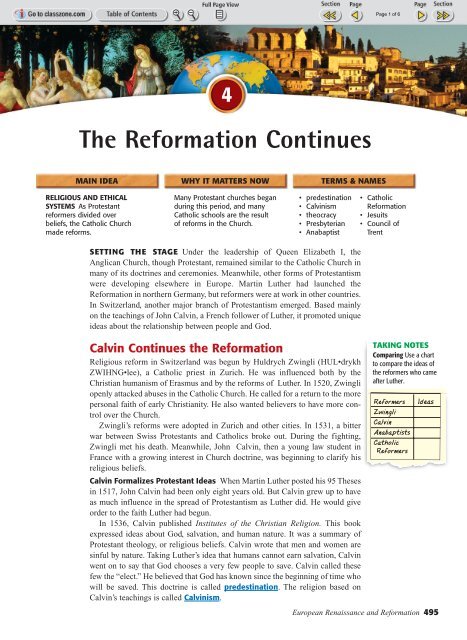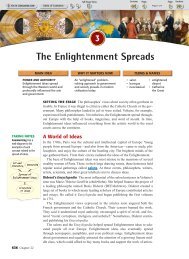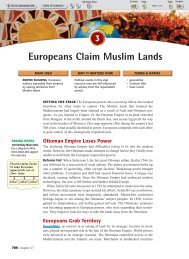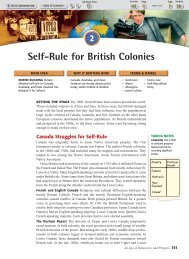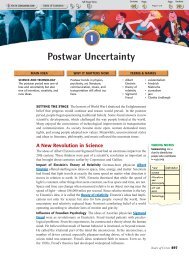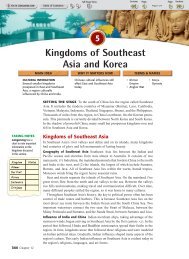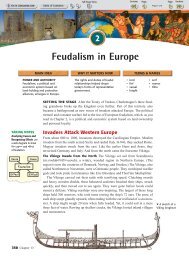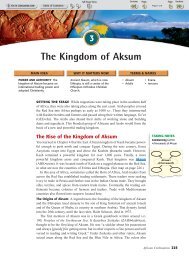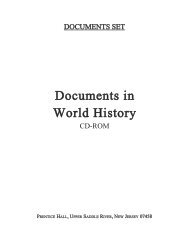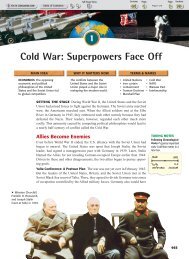The Reformation Continues - Euro-webonline.com
The Reformation Continues - Euro-webonline.com
The Reformation Continues - Euro-webonline.com
- No tags were found...
You also want an ePaper? Increase the reach of your titles
YUMPU automatically turns print PDFs into web optimized ePapers that Google loves.
4<strong>The</strong> <strong>Reformation</strong> <strong>Continues</strong>MAIN IDEA WHY IT MATTERS NOW TERMS & NAMESRELIGIOUS AND ETHICALSYSTEMS As Protestantreformers divided overbeliefs, the Catholic Churchmade reforms.Many Protestant churches beganduring this period, and manyCatholic schools are the resultof reforms in the Church.• predestination• Calvinism• theocracy• Presbyterian• Anabaptist• Catholic<strong>Reformation</strong>• Jesuits• Council ofTrentSETTING THE STAGE Under the leadership of Queen Elizabeth I, theAnglican Church, though Protestant, remained similar to the Catholic Church inmany of its doctrines and ceremonies. Meanwhile, other forms of Protestantismwere developing elsewhere in <strong>Euro</strong>pe. Martin Luther had launched the<strong>Reformation</strong> in northern Germany, but reformers were at work in other countries.In Switzerland, another major branch of Protestantism emerged. Based mainlyon the teachings of John Calvin, a French follower of Luther, it promoted uniqueideas about the relationship between people and God.Calvin <strong>Continues</strong> the <strong>Reformation</strong>Religious reform in Switzerland was begun by Huldrych Zwingli (HUL•drykhZWIHNG•lee), a Catholic priest in Zurich. He was influenced both by theChristian humanism of Erasmus and by the reforms of Luther. In 1520, Zwingliopenly attacked abuses in the Catholic Church. He called for a return to the morepersonal faith of early Christianity. He also wanted believers to have more controlover the Church.Zwingli’s reforms were adopted in Zurich and other cities. In 1531, a bitterwar between Swiss Protestants and Catholics broke out. During the fighting,Zwingli met his death. Meanwhile, John Calvin, then a young law student inFrance with a growing interest in Church doctrine, was beginning to clarify hisreligious beliefs.Calvin Formalizes Protestant Ideas When Martin Luther posted his 95 <strong>The</strong>sesin 1517, John Calvin had been only eight years old. But Calvin grew up to haveas much influence in the spread of Protestantism as Luther did. He would giveorder to the faith Luther had begun.In 1536, Calvin published Institutes of the Christian Religion. This bookexpressed ideas about God, salvation, and human nature. It was a summary ofProtestant theology, or religious beliefs. Calvin wrote that men and women aresinful by nature. Taking Luther’s idea that humans cannot earn salvation, Calvinwent on to say that God chooses a very few people to save. Calvin called thesefew the “elect.” He believed that God has known since the beginning of time whowill be saved. This doctrine is called predestination. <strong>The</strong> religion based onCalvin’s teachings is called Calvinism.TAKING NOTESComparing Use a chartto <strong>com</strong>pare the ideas ofthe reformers who cameafter Luther.ReformersZwingliCalvinAnabaptistsCatholicReformersIdeas<strong>Euro</strong>pean Renaissance and <strong>Reformation</strong> 495
John Calvin1509–1564A quiet boy, Calvin grew up to studylaw and philosophy at the Universityof Paris. In the 1530s, he wasinfluenced by French followers ofLuther. When King Francis I orderedProtestants arrested, Calvin fled.Eventually, he moved to Geneva.Because Calvin and his followersrigidly regulated morality in Geneva,Calvinism is often described as strictand grim. But Calvin taught thatpeople should enjoy God’s gifts. Hewrote that it should not be“forbidden to laugh, or to enjoy food,or to add new possessions to old.”Calvin Leads the <strong>Reformation</strong> in Switzerland Calvinbelieved that the ideal government was a theocracy, a governmentcontrolled by religious leaders. In 1541, Protestantsin Geneva, Switzerland, asked Calvin to lead their city.When Calvin arrived there in the 1540s, Geneva was aself-governing city of about 20,000 people. He and his followersran the city according to strict rules. Everyoneattended religion class. No one wore bright clothing orplayed card games. Authorities would imprison, ex<strong>com</strong>municate,or banish those who broke such rules. Anyone whopreached different doctrines might be burned at the stake.Yet, to many Protestants, Calvin’s Geneva was a model cityof highly moral citizens.Calvinism Spreads One admiring visitor to Geneva was aScottish preacher named John Knox. When he returned toScotland in 1559, Knox put Calvin’s ideas to work. Each<strong>com</strong>munity church was governed by a group of laymencalled elders or presbyters (PREHZ•buh•tuhrs). Followersof Knox became known as Presbyterians. In the 1560s,Protestant nobles led by Knox made Calvinism Scotland’sofficial religion. <strong>The</strong>y also deposed their Catholic ruler,Mary Queen of Scots, in favor of her infant son, James.Elsewhere, Swiss, Dutch, and French reformers adoptedthe Calvinist form of church organization. One reason Calvinis considered so influential is that many Protestant churchestoday trace their roots to Calvin. Over the years, however,many of them have softened Calvin’s strict teachings.In France, Calvin’s followers were called Huguenots.Hatred between Catholics and Huguenots frequently led toviolence. <strong>The</strong> most violent clash occurred in Paris onAugust 24, 1572—the Catholic feast of St. Bartholomew’s Day. At dawn, Catholicmobs began hunting for Protestants and murdering them. <strong>The</strong> massacres spread toother cities and lasted six months. Scholars believe that as many as 12,000Huguenots were killed.496 Chapter 17Other Protestant ReformersProtestants taught that the Bible is the source of all religious truth and thatpeople should read it to discover those truths. As Christians interpreted the Biblefor themselves, new Protestant groups formed over differences in belief.<strong>The</strong> Anabaptists One such group baptized only those persons who were oldenough to decide to be Christian. <strong>The</strong>y said that persons who had been baptized aschildren should be rebaptized as adults. <strong>The</strong>se believers were called Anabaptists,from a Greek word meaning “baptize again.” <strong>The</strong> Anabaptists also taught thatchurch and state should be separate, and they refused to fight in wars. <strong>The</strong>y sharedtheir possessions.Viewing Anabaptists as radicals who threatened society, both Catholics andProtestants persecuted them. But the Anabaptists survived and became the forerunnersof the Mennonites and the Amish. <strong>The</strong>ir teaching influenced the laterQuakers and Baptists, groups who split from the Anglican Church.Women’s Role in the <strong>Reformation</strong> Many women played prominent roles in the<strong>Reformation</strong>, especially during the early years. For example, the sister of KingAnalyzing CausesHow didProtestant teachinglead to the formingof new groups?
8° E24° E16° WReligions in <strong>Euro</strong>pe, 156058° N8° W0°8° EYO R W A16° ESCOTLAND– NSWEDENEdinburghA R K50° NIRELANDENGLANDNorthSeaD E N MBalticSeaATLANTICOCEAN0 200 Miles0400 KilometersParisLondonFRANCENETHERLANDSWormsMunsterGERMANSTATESAugsburgSWISSCONFEDERATIONGenevaWittenburgAUSTRIAViennaHUNGARYPOLAND-LITHUANIAPORTUGALAvignonMadridSevilleS P A I NBarcelona42° NMediterranean SeaITALIANSTATESRomeNaplesVenicePAPALSTATESNAPLESOTTOMANEMPIREConstantinopleSpread of Protestantism16° W8° WSCOTLAND0°58° NNORWAYSWEDEN16° E24° E50° NIRELANDENGLANDLondonFRANCEFLANDERSHOLY ROMANEMPIRESWISSCONFEDERATIONGenevaDENMARKBRANDENBURGWittenbergAUSTRIAVENETIANPRUSSIAPOLAND-LITHUANIASpread of ReligionLutheranAnglicanCalvinist34° NDominant ReligionRoman Catholic Eastern OrthodoxLutheranIslamAnglicanMixture of Calvinist,CalvinistLutheran, and RomanCatholicMinority ReligionRoman Catholic IslamLutheranAnabaptistCalvinist42° N34° NPORTUGALSPAIN0 400 Miles0CORSICA800 KilometersPAPALSTATESSARDINIAKINGDOMOFSICILYREPUBLICKINGDOMOFNAPLESOTTOMANEMPIREGEOGRAPHY SKILLBUILDER: Interpreting Maps1. Region Which <strong>Euro</strong>pean countries became mostly Protestantand which remained mostly Roman Catholic?2. Location Judging from the way the religions weredistributed, where would you expect religious conflicts totake place? Explain.<strong>Euro</strong>pean Renaissance and <strong>Reformation</strong> 497
Francis I, Marguerite of Navarre, protected John Calvin frombeing executed for his beliefs while he lived in France. Othernoblewomen also protected reformers. <strong>The</strong> wives of somereformers, too, had influence. Katherina Zell, married toMatthew Zell of Strasbourg, once scolded a minister for speakingharshly of another reformer. <strong>The</strong> minister responded by sayingthat she had “disturbed the peace.” She answered hiscriticism sharply:▲ Although Catholic,Marguerite ofNavarre supportedthe call for reformin the Church.PRIMARY SOURCEDo you call this disturbing the peace that instead of spending mytime in frivolous amusements I have visited the plague-infestedand carried out the dead? I have visited those in prison and undersentence of death. Often for three days and three nights I haveneither eaten nor slept. I have never mounted the pulpit, but Ihave done more than any minister in visiting those in misery.KATHERINA ZELL, quoted in Women of the <strong>Reformation</strong>Katherina von Bora played a more typical, behind-the-scenes role as Luther’s wife.Katherina was sent to a convent at about age ten, and had be<strong>com</strong>e a nun. Inspired byLuther’s teaching, she fled the convent. After marrying Luther, Katherina had six children.She also managed the family finances, fed all who visited their house, and supportedher husband’s work. She respected Luther’s position but argued with him aboutwoman’s equal role in marriage.As Protestant religions became more firmly established, their organizationbecame more formal. Male religious leaders narrowly limited women’s activities tothe home and discouraged them from being leaders in the church. In fact, it wasLuther who said, “God’s highest gift on earth is a pious, cheerful, God-fearing,home-keeping wife.”<strong>The</strong> Catholic <strong>Reformation</strong>While Protestant churches won many followers, millions remained true toCatholicism. Helping Catholics to remain loyal was a movement within theCatholic Church to reform itself. This movement is now known as the Catholic<strong>Reformation</strong>. Historians once referred to it as the Counter <strong>Reformation</strong>. Importantleaders in this movement were reformers, such as Ignatius (ihg•NAY•shuhs) ofLoyola, who founded new religious orders, and two popes—Paul III and Paul IV—who took actions to reform and renew the Church from within.Ignatius of Loyola Ignatius grew up in his father’s castle in Loyola, Spain. <strong>The</strong>great turning point in his life came in 1521 when he was injured in a war. Whilerecovering, he thought about his past sins and about the life of Jesus. His dailydevotions, he believed, cleansed his soul. In 1522, Ignatius began writing a bookcalled Spiritual Exercises that laid out a day-by-day plan of meditation, prayer, andstudy. In it, he <strong>com</strong>pared spiritual and physical exercise:MakingInferencesWhy was iteasier for womento take part in theearlier stages of the<strong>Reformation</strong> than inthe later stages?PRIMARY SOURCEJust as walking, traveling, and running are bodily exercises, preparing the soul toremove ill-ordered affections, and after their removal seeking and finding the will ofGod with respect to the ordering of one’s own life and the salvation of one’s soul, areSpiritual Exercises.IGNATIUS OF LOYOLA, Spiritual Exercises498 Chapter 17
Vocabulary<strong>The</strong> Inquisition wasa papal judicialprocess establishedto try and punishthose thought to beheretics.For the next 18 years, Ignatius gathered followers. In 1540, the pope created areligious order for his followers called the Society of Jesus. Members were calledJesuits (JEHZH•u•ihts). <strong>The</strong> Jesuits focused on three activities. First, they foundedsuperb schools throughout <strong>Euro</strong>pe. Jesuit teachers were well-trained in both classicalstudies and theology. <strong>The</strong> Jesuits’ second mission was to convert non-Christians to Catholicism. So, they sent out missionaries around the world. <strong>The</strong>irthird goal was to stop the spread of Protestantism. <strong>The</strong> zeal of the Jesuits overcamethe drift toward Protestantism in Poland and southern Germany.▲ Church leadersconsult on reformsat the Council ofTrent in this 16thcenturypainting.Reforming Popes Two popes took the lead in reforming the Catholic Church.Paul III, pope from 1534 to 1549, took four important steps. First, he directed acouncil of cardinals to investigate indulgence selling and other abuses in theChurch. Second, he approved the Jesuit order. Third, he used the Inquisition to seekout heresy in papal territory. Fourth, and most important, he called a council ofChurch leaders to meet in Trent, in northern Italy.From 1545 to 1563, at the Council of Trent, Catholic bishops and cardinalsagreed on several doctrines:• <strong>The</strong> Church’s interpretation of the Bible was final. Any Christian whosubstituted his or her own interpretation was a heretic.• Christians needed faith and good works for salvation. <strong>The</strong>y were not saved byfaith alone, as Luther argued.• <strong>The</strong> Bible and Church tradition were equally powerful authorities for guidingChristian life.• Indulgences were valid expressions of faith. But the false selling ofindulgences was banned.<strong>The</strong> next pope, Paul IV, vigorously carried out the council’s decrees. In 1559,he had officials draw up a list of books considered dangerous to the Catholic faith.This list was known as the Index of Forbidden Books. Catholic bishops throughout<strong>Euro</strong>pe were ordered to gather up the offensive books (including ProtestantBibles) and burn them in bonfires. In Venice alone, followers burned 10,000 booksin one day.<strong>Euro</strong>pean Renaissance and <strong>Reformation</strong> 499
Jesuit Missionaries<strong>The</strong> work of Jesuit missionarieshas had a lasting impact around theglobe. By the time Ignatius died in1556, about a thousand Jesuits hadbrought his ministry to <strong>Euro</strong>pe, Africa,Asia, and the Americas. Two of themost famous Jesuit missionaries ofthe 1500s were Francis Xavier, whoworked in India and Japan, andMatteo Ricci, who worked in China.One reason the Jesuits had such animpact is that they founded schoolsthroughout the world. For example,the Jesuits today run about 45 highschools and 28 colleges anduniversities in the United States. Fourof these are Georgetown University(shown above), Boston College,Marquette University, and LoyolaUniversity of Chicago.<strong>The</strong> Legacy of the <strong>Reformation</strong><strong>The</strong> <strong>Reformation</strong> had an enduring impact. Through itsreligious, social, and political effects, the <strong>Reformation</strong> setthe stage for the modern world. It also ended the Christianunity of <strong>Euro</strong>pe and left it culturally divided.Religious and Social Effects of the <strong>Reformation</strong> Despitereligious wars and persecutions, Protestant churches flourishedand new denominations developed. <strong>The</strong> RomanCatholic Church itself became more unified as a result of thereforms started at the Council of Trent. Both Catholics andProtestants gave more emphasis to the role of education inpromoting their beliefs. This led to the founding of parishschools and new colleges and universities throughout <strong>Euro</strong>pe.Some women reformers had hoped to see the status ofwomen in the church and society improve as a result of the<strong>Reformation</strong>. But it remained much the same both underProtestantism and Roman Catholicism. Women were stillmainly limited to the concerns of home and family.Political Effects of the <strong>Reformation</strong> As the CatholicChurch’s moral and political authority declined, individualmonarchs and states gained power. This led to the developmentof modern nation-states. In the 1600s, rulers of nationstateswould seek more power for themselves and theircountries through warfare, exploration, and expansion.<strong>The</strong> <strong>Reformation</strong>’s questioning of beliefs and authority alsolaid the groundwork for the Enlightenment. As you will readin Chapter 22, this intellectual movement would sweep <strong>Euro</strong>pein the late 18th century. It led some to reject all religions andothers to call for the overthrow of existing governments.SECTION4ASSESSMENTTERMS & NAMES 1. For each term or name, write a sentence explaining its significance.• predestination • Calvinism • theocracy • Presbyterian • Anabaptist • Catholic <strong>Reformation</strong> • Jesuits • Council of TrentUSING YOUR NOTES2. Which Catholic reform do youthink had the most impact?ReformersZwingliCalvinAnabaptistsCatholicReformersIdeasMAIN IDEAS3. What was Calvin’s idea of the“elect” and their place insociety?4. What role did noblewomenplay in the <strong>Reformation</strong>?5. What were the goals of theJesuits?CRITICAL THINKING & WRITING6. DRAWING CONCLUSIONS How did the <strong>Reformation</strong> setthe stage for the modern world? Give examples.7. MAKING INFERENCES Why do you think the Churchwanted to forbid people to read certain books?8. COMPARING How did steps taken by Paul III and Paul IVto reform the Catholic Church differ from Protestantreforms? Support your answer with details from the text.9. WRITING ACTIVITY RELIGIOUS AND ETHICAL SYSTEMS Write atwo-paragraph essay on whether church leaders shouldbe political rulers.CONNECT TO TODAYPRESENTING AN ORAL REPORTResearch the religious origins of a university in the United States. <strong>The</strong>n present your findingsto the class in an oral report.500 Chapter 17


